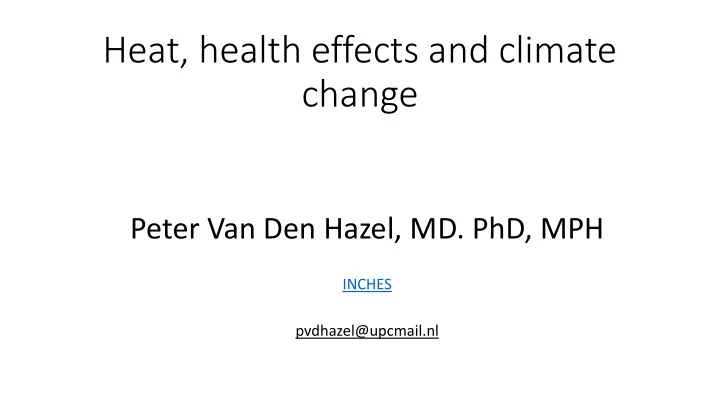

Heat, health effects and climate change Peter Van Den Hazel, MD. PhD, MPH INCHES pvdhazel@upcmail.nl
• Introduction about background • Changes • Monitoring • Effects • Action
Background
Source: KWR
Issues • Lack of rainfall • Heatstress
HOW TO BEHAVE IN THE DUTCH CLIMATE
CURRENT SITUATION 2016 In top 10 hottest summers since 1901 2017 Hottest june 15th since 1901 2018 Hottest may month in 300 years Hottest night in may since 1901 Hottest day in may ever measured
SCENARIO’S According to climate scenarios of the Dutch Royal Meteorological Institute (KNMI), the Netherlands will be facing more and longer periods of high and even tropical temperatures (in 2050, twice as much as in the present situation). http://www.climatecentral.org/news/global-cities-climate-change-21584
HEATWAVES Hoyois P, Below R, Scheuren J-M, Guha-Sapir D. Annual Disaster Statistical Review: Numbers and Trends 2006. (Centre for Research on the Epidemiology of Dis- asters (CRED), School of Public Health, Catholic University of Louvain Brussels, Belgium, Brussels, 2007).
PHYSICAL MAPPING • Surface water Building skin • • Paved areas • Experiencing heat • Heat flows • Difference in temperature indoors- outdoors
https://ruimtelijkeadaptatie.nl/hulpmiddelen/klimaateffectatlas/ http://www.klimaateffectatlas.nl/nl/
SOCIAL MAPPING • Age 75+ • Mortality comparison 2006 versus 2000-2013
ACTION PLANNING Behaviour National Heat Plan (RIVM) Extrema app Public space Creating shade Depaving Waterplaza’s Housing Behaviour Sun screens Ventilation
National Heatplan (2015) RIVM (National Institute for Health and Environment) Warns and supports Public Health Services in the region RIVM can activate the National Heatplan in cooperation with National Meteorological Institute
Local Heatplan (2019)
Vulnerable groups HEALTH • Age + 75 • Young children • People with chronical diseases like astma Creating awareness on how to behave during tropical periods
Infographic
EXTREMA App Promote Awareness of the risk of heat stress at an individual level. Offer Direct Action perspective "on location" Source: drs. Guusje Eggen, Medisch Milieukundig Adviseur - GGD Rotterdam Rijnmond
Intervention Target group: elderly, young children Aim: promote heatstress reducing behaviour Determinants: • Stimulate knowledge about heat • Increase risk perception about heat • Reduce barriers to heatstress reducing behaviour • Increase social cues to action Use intervention functions: • Education • Convincing • Adjustment to environment • Facilitating Source: Thierry van Denzel. Warm, warmer, warmst. Amsterdam University of Applied Sciences. 2017
Source: The behaviour change wheel: A new method for characterising and designing behaviour change interventions - Susan Michie, Maartje M van Stralen, Robert West. Implement Sci. 2011; 6: 42.
1. Education 2. Persuasion 3. Incentivisation 4. Coercion 5. Training 6. Restriction 7. Environmental restucturing 8. Modeling 9. Enablement
Long term PLANNING 2006 ----------------------------------2007--------------------------- 2009------------------------------ 2013 -----------------2017 --------------------2018 --------> Double Heatwave National Heat Plan RIVM UHIE-Knowledge for Climate RAS & Hotterdam NAS Rotterdam Delta Plan
Recommend
More recommend